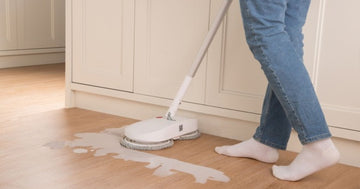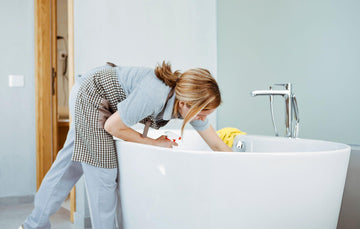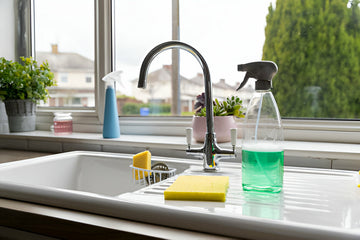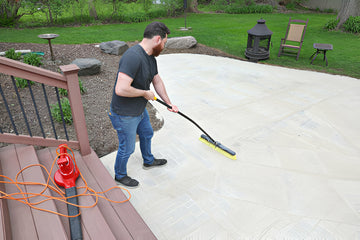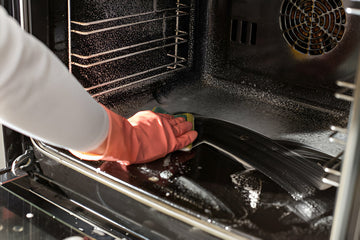Introduction
Have you ever mopped your floor only to find it sticky afterwards? It's annoying, right? You aren't the only one. The endless frustration of the sticky floor after mopping is a commonplace thing. However, do not worry! There are easygoing ways to solve your irritating problem. Read on to discover why your floor is sticky after mopping and then fix it. So, let us roll up our sleeves and do it together!
Why Does My Floor Stay Sticky After I Mop It?
Various reasons lead to post-mop sticky floors. So, before finding a solution, let's focus on the reasons.
Wrong Cleaning Solution
If you mopped the floor and it still feels sticky, one possible reason is that you applied the wrong cleaning solution. Many cleaning products contain components that can leave residue behind, particularly if they are not properly diluted or just not fit for your flooring material.
For hardwood floors, use a surfactant and water-based solvent cleaner such as isopropyl alcohol which will do a good job dissolving dirt without damaging the wood. The laminate floors require cleaners with non-aggressive surfactants and water-based solvents like ethyl alcohol to keep their durability. Grout and tile floors can be efficiently cleaned with solutions made up of neutral pH surfactants and chelating agents like citric acid which remove dirt without causing any damage.

Excessive Use of Floor Sanitizer
Another possible cause of a sticky floor after mopping is too much cleaning solution. Over-pouring will leave behind a film that is sure to resist scrubbing off. This makes your floor feel sticky and dirty all over again. For example, if the instructions ask to mix 1/4 cup of cleaner with 1 gallon of water, but you are desperate to add more cleaner, you might face a problem.
Remember that the amount of product indicated on the label should be strictly followed to prevent leaving behind a soapy residue. Note that most cleaning products come with these measuring cups to ensure you get the right amount of each cleaning agent every time you use them.
Using Dirty Water
Your floor may feel sticky after mopping due to a commonly overlooked issue: the use of dirty water. You are not cleaning; you are spreading dirt when you mop with polluted water or water loaded with dust.
Solution? If the water gets muddy while you clean, replace it with clean water for better cleaning. Try a different bucket for rinsing your mop to prevent the dirt from being transferred to the floor again. Wipe down the floors with a microfiber mop that does not leave dirt behind but separates the clean and dirty water, making the cleaning efficient.

Proper Mopping Techniques for Various Flooring Types
Learn how to keep your floor in the best possible condition with high-quality mops available. Each type of flooring requires a different type of care from hardwood to tile to ensure its durability and good appearance. Let's dig into mopping methods that are more suitable for various surfaces to ensure a thorough cleaning without causing any damage or residue build-up.
Hardwood Floor
When mopping hardwood floors, it's crucial to prevent water from seeping into the wood, as this can cause warping or other damage over time. Start by thoroughly sweeping or vacuuming to eliminate any dirt, dust, or debris that can scratch the surface. Use a vacuum with a floor-brush attachment to reach corners and crevices effectively.
Once the floor is free of loose dirt, prepare to mop, and use a damp (not wet) mop with a standard hardwood floor cleaning solution. Ensure the mop is only lightly dampened to avoid excessive moisture. Mop in the direction of the wood grain to minimize streaks and help preserve the floor's natural beauty.
After mopping, dry the floor immediately with a clean, dry cloth or towel to ensure no moisture remains on the surface.
Vinyl
Vinyl flooring offers a blend of durability and ease of maintenance, making it a popular choice for many homeowners. To achieve optimal results when mopping vinyl floors, you need to begin by sweeping or vacuuming to remove any debris or dust particles on the surface. Then, proceed to mop the floor using a wet mop paired with either a specialized vinyl floor cleaner or a gentle solution of water and mild soap.
It's essential to refrain from using scouring pads or abrasive cleaners, as they have the potential to scratch the surface. Once mopping is complete, allow the floor to air dry thoroughly to prevent any sticky residue from lingering.
Tile
While cleaning up tile floors, begin with sweeping or vacuuming to remove the usable dust and particles. For grouts with tile lines, use a brush or grout cleaner to deal with the stains. Further, mop the tile surface with a pH-neutral or mild alkaline cleansing agent. Change the water in the mop often to avoid streaking, and use a clean towel to dry the floor and prevent water spots from appearing.

Laminate
Laminate flooring should be cleaned with a slightly (not completely) wet mop to avoid water damage. Start sweeping or vacuuming to get rid of dirt particles and dust. Next, use the floor cleaner for laminate floors or a mixture of water and vinegar to mop the floor. Avoid cleaning agents with the wax base and abrasive instruments because they can damage the surface. Keep rinsing the mop occasionally and dry the floor with a clean towel to avoid any streaks on the floor.
Remedies for Removing Sticky Residue from Floors
Identify the Residue
Before cleaning, ensure you know what kind of sticky stuff you face. This may include juice, tape residue, or even gum. Knowing your enemy means knowing what weapon to use to eliminate it.
Gentle Solutions for Delicate Floors
For resilient floors, like hardwood or laminate, begin with the mildest solutions. Add warm water and a small amount of dish soap to the stain, and then apply the mixture with a soft cloth or sponge. Do not use chemicals that may stain the finish.

Oil-Based Solutions for Stubborn Residue
Oil-based solutions are the next best resort if the gooey mess is uncooperative. An example of a natural ingredient that can help break down the stickiness is coconut oil, vegetable oil, or even peanut butter. The process is simple. Apply a small amount, and let it sit for a few minutes before wiping it away with a clean cloth.
Commercial Cleaners for Tough Cases
Finally, when all else has failed, it's time to get the big shots involved. Various commercial cleaners are particularly effective at removing sticky deposits from floors. Consider reading the instructions well and starting small to check the paint effect.
Post-Cleaning Care
After you've taken the trouble to clean the sticky residue, give your floor a little love. Wipe it off with a damp towel to remove the rest of the residue or cleaner, and after that, dry it thoroughly to stop water damage. Being familiar with the necessary maintenance will reduce the chances of getting into sticky situations.
Preventative Measures to Avoid Sticky Floors After Mopping
Choose the Right Cleaning Agent
Selecting a suitable cleaning agent to remove stickiness is among the most critical steps in cleaning that does not leave a sticky residue. Determine your flooring material, whether hardwood, tiles, laminate, or vinyl, and pick a cleaning solution designed for that particular flooring surface. Moreover, cleaners free from harsh chemicals and fragrances should be chosen to avoid contaminating the remaining residues.
Dilution Matters
The concentration of your cleaning product is crucial for its effectiveness. Following the manufacturer's recommendation ensures the cleaner is potent enough to clean properly without leaving extra residue on the floor. Carefully measure the cleaning solution and mix it with water according to the instructions. Avoid using more cleaner than recommended, as this can cause it to cling to the surface and require extra rinsing.

Rinse Thoroughly
Mopping with the cleaning solution is only part of the process. To prevent stickiness and ensure a spotless floor, thoroughly rinse away any remaining solution. Spray the entire floor with clean water, paying special attention to edges and corners where residue can accumulate. For faster results, add some white vinegar to the rinsing water; the acidity of the vinegar helps remove residue and leaves your floor shining.
Use Clean Mop Heads
Using old and filthy mop heads is just as bad as cleaning the floors with dirty water, which transfers dirt from the mop to the floors. Be sure to wash the mop head in the hot water with a mild detergent before using it. Replace them often with fresh disposable mop heads because they may not work well if you use the same one for different areas of the house, and you may have a chance of cross-contamination.
Final Thoughts
Getting sticky floors after mopping can be baffling and irritating, but this can be easily overcome with simple tricks to clean the floors. Knowing why floors get sticky and the steps to prevent it, you'll always have shiny, smooth floors after mopping.
The most important thing is learning about leftover cleaning stuff, selecting good cleaning products, handling hard water stains, keeping mop heads clean, and not using too much cleaning stuff. Familiarising yourself with these sticky floor cleaning hacks will help keep floors clean and looking good.
FAQs
Q1: Are there any DIY solutions to prevent sticky floors after mopping?
Yes, there are! A homemade method is to squeeze a little white vinegar into your mop water. Vinegar's acidity is responsible for cutting through any residual cleaning products, ensuring your floors are clean and less likely to get sticky. Yet another consideration is the use of a combination of warm water and a few drops of dish-washing soap that will clean the floors without leaving them sticky.
Q2: Does the water hardness impact the stickiness of the floor after mopping?
Yes! Hard water, which contains high levels of minerals like calcium and magnesium, creates a white residue on your floors when you mop. This residue may result in a sticky and dull appearance. To create small quantities of soft water for cleaning, you may boil the water and let it cool, then filter out the white mineral deposits.
Q3: Are there specific mop techniques I can employ to minimize stickiness?
Yes, indeed! One of the methods is mopping in small areas, using an overlapping stroke pattern to ensure that surfaces are well covered. Too much water or cleaner can cause stickiness; thus, be careful with the water or cleaning solution. Besides that, remember to periodically rinse your mop while mopping to avoid spreading dirt and residue. Once you are done with mopping, go for dry mopping or wiping with a towel to take out the moisture left on the floor.

